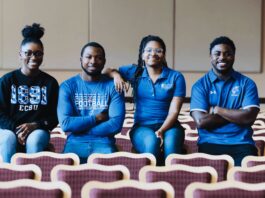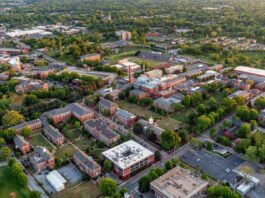Civil rights leader, Morehouse Man and community titan Charles Cherry Sr. is getting a building named after him in Daytona, Florida! Learn more in the The Daytona Beach News-Journal story below.

Pictured is Daytona Beach City Manager Deric Feacher in the spring of 2021 when he was interviewing for the top city government job and speaking to residents at the Midtown neighborhood community center. (Photo Credit: Nadia Zomorodian/News-Journal)
The Midtown Cultural & Educational Center, a top quality community center with everything from a dance studio to a computer room, is getting a new name.
Daytona Beach city commissioners unanimously agreed at their meeting Wednesday night to rename the 10-year-old facility the Julia T. and Charles W. Cherry, Sr. Cultural & Educational Center.
Charles Cherry, Sr., was a longtime Daytona Beach city commissioner, head of the Volusia County branch of the NAACP, civil rights leader and managing editor of the Daytona Times newspaper. Julia Mae Troutman-Cherry was a teacher, an assistant counselor of women at Bethune-Cookman University and an active member of Hope Fellowship Church.
“I think these are two very, very worthy people to have a facility named after them,” said City Commissioner Ruth Trager.
City Commissioner Paula Reed, whose zone includes the city-owned community center on George Engram Boulevard just east of Nova Road, led the effort to rename the 24,830-square-foot facility.
One idea was to call the building the Julia T. and Charles W. Cherry, Sr. Community Center, but Mayor Derrick Henry didn’t want to lose the references to education, culture and the Midtown neighborhood.
The Julia T. and Charles W. Cherry, Sr. Midtown Cultural & Educational Center, however, sounded like too long of a name to be stretched across the top of the building, Henry said.
Since the area around the building also encompasses Cypress Park and Cypress Aquatic Center, the three facilities could collectively be called the Midtown complex, Reed said. Henry liked that idea.
“I don’t think you could have done a better job of bridging our past and our future,” the mayor said.
Who was Charles Cherry, Sr.?
The Midtown Cultural & Educational Center opened in 2012, and it remains one of the city government’s nicest and newest buildings. It’s been used for everything from meetings, to COVID vaccines to basketball games.
The large building includes a gymnasium with basketball courts, dance studio, music studio, kitchen, computer room and meeting rooms.

Charles Cherry, Sr., died in 2004, eight years before the building opened. But now his name will be on the community gathering spot, and it will be a chance for both kids and adults to learn about him.
Cherry was born in Georgia in 1928, and he graduated from Morehouse College in 1949. He served in the U.S. Army from 1950 to 1952 during the Korean War.
He was a father of three and husband for 51 years.
He was a realtor, entrepreneur, bail bondsman, newspaper editor, Campbell Street High School teacher and Bethune-Cookman business professor. He served as the Zone 6 Daytona Beach city commissioner from 1995 until November 2004, when he died.
Cherry was the first Black person to be admitted to the Daytona Beach Board of Realtors in 1967.
He was president of the Volusia County Branch of the NAACP from 1971-1980, and from 1995 to 2001. He also held state and national positions within the NAACP in the 1970s and 1980s.
From 1985 to 1991, he was the founder and president of a Daytona Beach chamber of commerce that represented small businesses that didn’t feel adequately represented by the city’s main chamber of commerce.
He organized and unionized hotel maids and city garbage collectors. And one of his proudest achievements was helping to free two Black men who had been on death row for 12 years for the murder of two white gas station attendants. In 1975, Florida Gov. Reuben Askew pardoned both men.
Cherry’s activism led to death threats, and he had body guards and 24-hour security at his home. The Cherry family lived in a custom-built, two-story building on Orange Avenue that had solid concrete walls to protect them from bomb blasts.




